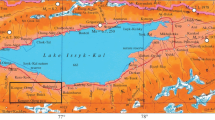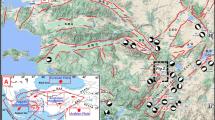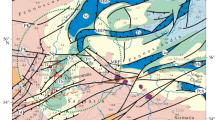Abstract
In the recent structure of the Baikal Rift Zone, the Kichera Fault serves as the northwestern boundary of the Angara-Kichera aggradation depression. A seismotectonic scarp 60 m high was formed as a result of normal faulting during the late Pleistocene and Holocene. The erosion-aggradation and seismic landforms testify to the nonuniform growth of this scarp. To study the character of the seismic activity in the Kichera Fault Zone, we excavated two trenches across the seismotectonic scarp. The Holocene stage of the seismotectonic activation within the fault zone and the preceding period of relative quiescence were outlined from the character of the deformations in the trench sections and previous geomorphic investigations. According to our preliminary estimations, the active stage that started at the end of the late Pleistocene and that has remained incomplete until now was accompanied by at least three rupture-forming earthquakes.
Similar content being viewed by others
References
D. B. Bazarov, The Cenozoic of the Baikal and Western Transbaikal Region (Nauka, Novosibirsk, 1986) [in Russian].
Geomorphology in the Northern Cisbaikal Region and the Stanovoi Highland, Ed. by A. G. Zolotarev (Nauka, Moscow, 1981) [in Russian].
A. S. Endrikhinskii, “Borders and Geomorphologic Zonation of the Stanovoy Highland,” in Topography and Quaternary Deposits of the Stanovoy Highland (Nauka, Moscow, 1981), pp. 6–19 [in Russian].
A. S. Endrikhinskii, “Late Cenozoic Evolution of the Drainage System of the Stanovoy Highland,” in Topography and Quaternary Deposits of the Stanovoi Highland (Nauka, Moscow, 1981), pp. 135–166 [in Russian].
Yu. A. Zorin, Neotectonic Structure and Isostasy of the Baikal Rift Zone and Adjacent Territory (Nauka, Moscow, 1972) [in Russian].
K. G. Levi and A. A. Kul’chitskii, “Peneplains in the Northeastern Part of the Baikal Rift Zone,” in Topography and Quaternary Deposits of the Stanovoy Highland (Nauka, Moscow, 1981), pp. 19–35 [in Russian].
Baikal and Transbaikal Region Highlands. Evolution of Topography in Siberia and the Far East, Ed. by N. A. Florensov (Nauka, Moscow, 1974) [in Russian].
L. E. Ivanov, Explanatory Note to Geologic Map N-49-III (1: 200 000), Ed. by S. A. Gurulev (Moscow, 1975) [in Russian].
O. P. Smekalin, A. V. Chipizubov, V. S. Imaev, et al., “New Opportunities in Studying Seismic Deformations Using Remote Scanning of the Surface (Based on the Kichera Paleoseismic Structure),” in Proceedings of Scientific-Practical Conference. 30th Anniversary of the Neryungri City, Neryungri, 2005 (Yakut. Univ., Neryungri, 2005), pp. 143–162 [in Russian].
A. L. Strom, “Correlation of Recent and Paleoseismic Deformation Parameters,” Fiz. Zemli, No. 9, 38–42 (1993).
A. G. Trofimov, “The Dushkachanskaya Terrace of the North Baikal Trough,” in Proceedings of Regional Conference on Applied Geomorphology and Neotectonics (IZC Sib. Otd. Akad. Hauk SSSR, Irkutsk, 1988), pp. 15–16 [in Russian].
A. G. Trofimov, Candidate’s Dissertation in Geology and Mineralogy (Irkutsk, 1994).
N. A. Florensov, “Neotectonics of the Cisbaikal Region in Terms of Seismisity,” in Bulletin of Seismological Committee. No. 10: Problems of Seismotectonics of the Cisbaikal Region and Adjacent Territory (Akad. Nauk SSSR, Moscow, 1960), pp. 11–20 [in Russian].
V. S. Khromovskikh, V. P. Solonenko, et al., “On Seismotectonic Characteristics of the Northern Cisbaikal Region,” in Seismisity and Deep Structure of the Cisbaikal Region (Nauka, Novosibirsk, 1978), p. 101–107 [in Russian].
A. V. Chipizubov, Candidate’s Dissertation in Geology and Mineralogy (Irkutsk, 1982).
A. V. Chipizubov, “Recognition of Monophase and Coeval Paleoseismic Deformations and Determination of Paleoearthquake Magnitudes from Their Extent,” Geol. Geofiz. 39, 386–398 (1998).
A. A. Yatsenko, “Observation of Some River Terraces in the Baikal Mountain Area,” Izv. Akad. Nauk SSSR, No. 6, 101–107 (1956).
J. P. McCalpin, Paleoseismology (Academic Press, San Diego, 1996).
J. P. McCalpin, “Late Quaternary Activity of the Pajarito Fault, Rio Grande Rift of the Northern New Mexico, USA,” Tectonophysics 408, 213–236 (2005).
D. L. Wells and K. J. Copersmith, “Empirical Relationship among Magnitude, Ruptive Length, Rupture Area, and Surface Displacement,” Bull. Seismol. Soc. Am. 84, 974–1002 (1994).
Author information
Authors and Affiliations
Additional information
Original Russian Text © O.P. Smekalin, A.V. Chipizubov, V.S. Imaev, V.M. Besstrashnov, A.I. Mel’nikov, 2007, published in Tikhookeanskaya Geologiya, 2007, Vol. 1, No. 2, pp. 82–92.
Rights and permissions
About this article
Cite this article
Smekalin, O.P., Chipizubov, A.V., Imaev, V.S. et al. Paleoseismological investigation of the Kichera Fault Zone in the northern Baikal region. Russ. J. of Pac. Geol. 1, 176–185 (2007). https://doi.org/10.1134/S1819714007020066
Received:
Issue Date:
DOI: https://doi.org/10.1134/S1819714007020066




